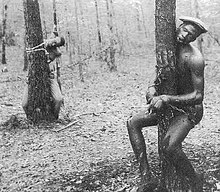Lynching in the United States
Lynching is a form of murder. It is normally by hanging. Lynching is often by a group of people as a form of punishment. In the United States, lynchings happened more often after the American Civil War in the early-to-mid 1860s.[1]

Although the number of lynchings went down in the 1920s, they have continued into the 21st century.[2]
Most, but not all, lynchings were of African American men in the South. Ninety-two women were lynched in the United States between 1882 and 1927. The lynchings of black people by white people happened in the Midwest and border states. There were also lynchings of Native Americans, Hispanics and Asian Americans in the West.[3] White people were also lynched but these lynchings were less common.
According to the Tuskegee Institute, 4,743 people were lynched between 1882 and 1968 in the United States. This includes 3,446 African Americans and 1,297 whites. More than 73 percent of lynchings after the Civil War happened in the Southern states.[4] According to the Equal Justice Initiative, 4,084 African-Americans were lynched between 1877 and 1950 in the South.[5] Whites lynched blacks to defend white supremacy. Blacks were lynched for violating social norms, including segregation (the separation of whites and blacks), and the lower status of blacks. White acted together to lynch an individual black person.[6] In the Deep South, lynching was also used to scare blacks away from voting.[7]
After the Civil War, nearly four million slaves in the South were made free. In some states and many counties, freed blacks made up over half the people who lived there. The first Ku Klux Klan was founded in 1866 by Confederate veterans in Tennessee. Ku Klux Klan groups were then founded by veterans throughout the South. They wanted to keep African Americans in fear, as they were before the war. This was when lynchings became common. In the 1890s, African American journalist and anti-lynching fighter Ida B. Wells was one of the first people to study lynching cases. She found that black lynching victims were accused of rape or attempted rape about one-third of the time. The most common accusation was murder or attempted murder. Other accusations were verbal and physical aggression, competitive businesses and independent thinking.[8] In 1940, sociologist Arthur F. Raper investigated one hundred lynchings after 1929. He said that about one-third of the victims were falsely accused.[9]
The stereotype of lynching is hanging. Hangings are what crowds of people saw. Hanging is also easy to photograph.[10] There are other forms of lynching. They include being shot repeatedly, being burned, dragged behind cars and being forced to jump from a bridge.[11]
In the late-1800s to early-1900s South, photographs were taken at lynchings. These were used in postcards and newspapers.[12] These images usually showed an African-American lynching victim and all or part of the crowd that attended. Women and children often watched lynchings. The people who killed the victim were not identified.[13] At one lynching, nearly 15,000 people were in the crowd.[12] Often lynchings were advertised in newspapers before the event so photographers could be there.[14] After the lynching, photographers would sell their pictures as-is or as postcards. They could cost as much as fifty cents each, or $9, as of 2016.[13]
Lynching demographics (worst years for lynchings in the United States)
change| Year | White Victim | Black Victim | Total Victims |
|---|---|---|---|
| 1892 | 69 | 161 | 230 |
| 1884 | 160 | 51 | 211 |
| 1894 | 58 | 134 | 192 |
| 1885 | 110 | 74 | 184 |
| 1891 | 71 | 113 | 184 |
| 1895 | 66 | 113 | 179 |
| 1889 | 76 | 94 | 170 |
| 1897 | 35 | 123 | 158 |
| 1893 | 34 | 118 | 152 |
| 1886 | 64 | 74 | 138 |
References
change- ↑ Civil War Legacy Lynchings accounts and pictures
- ↑ DeNeen L. Brown (2021-08-08). "'Lynchings in Mississippi never stopped'". The Washington Post.
- ↑ Lynching in the West. The Duke University Press. Archived from the original on June 12, 2018. Retrieved October 19, 2018.
- ↑ "Lynching, Whites and Negroes, 1882 – 1968" (PDF). Tuskegee University. Archived from the original (PDF) on March 13, 2016.
- ↑ Lynching in America: Confronting the Legacy of Racial Terror (Report) (3rd ed.). Montgomery, Alabama: Equal Justice Initiative. 2017. Archived from the original on 2018-05-10.
- ↑ Smångs, Mattias (2016). "Doing Violence, Making Race: Southern Lynching and White Racial Group Formation". American Journal of Sociology. 121 (5): 1329–1374. doi:10.1086/684438. PMID 27092388. S2CID 10753622.
- ↑ White, Paul; Strickler, Ryan; Witko, Christopher; Epperly, Brad (2019). "Rule by Violence, Rule by Law: Lynching, Jim Crow, and the Continuing Evolution of Voter Suppression in the U.S.". Perspectives on Politics. 18 (3): 756–769. doi:10.1017/S1537592718003584. S2CID 225243828.
- ↑ Ifill, Sherrilyn A. (2007). On the Courthouse Lawn: Confronting the Legacy of Lynching in the Twenty-First Century. Boston: Beacon.
- ↑ Myrdal, Gunnar (1944). An American Dilemma. New York: Harper. p. 561.
- ↑ "Legacy of Lynching". PBS. Retrieved October 19, 2018.
- ↑ An Obsessive Quest (Report). Archived from the original on March 18, 2017. Retrieved October 19, 2018.
- ↑ 12.0 12.1 Ifill, Sherrilyn A. (2007). On the Courthouse Lawn: Confronting the Legacy of Lynching in the Twenty-First Century. Boston: Beacon.
- ↑ 13.0 13.1 Goff, Jennie (2011). Blood at the Root Lynching as American Cultural Nucleus. Albany: State U of New York.
- ↑ Kim, Linda (2012). "A Law of Unintended Consequences: United States Postal Censorship of Lynching Photographs". Visual Resources. 28 (2): 171–193. doi:10.1080/01973762.2012.678812. S2CID 159670864.